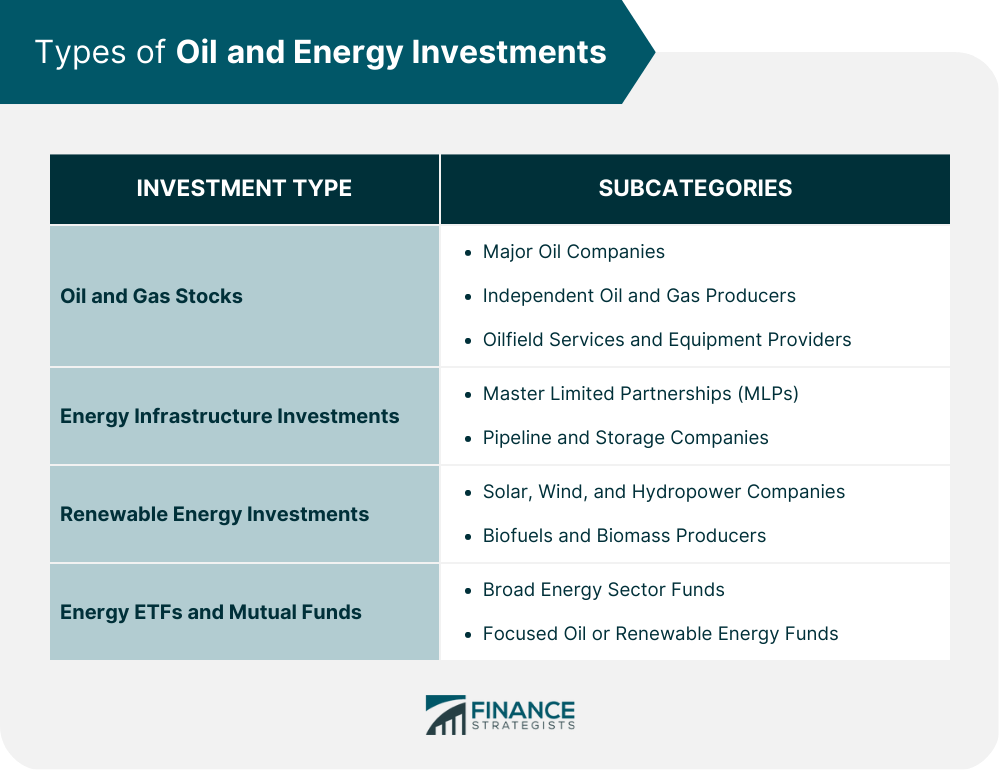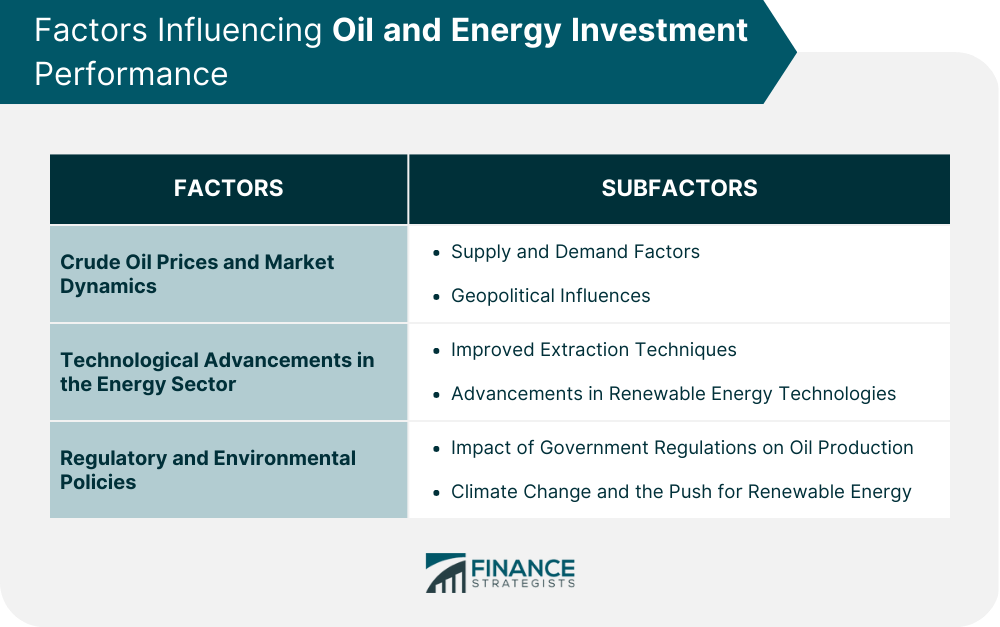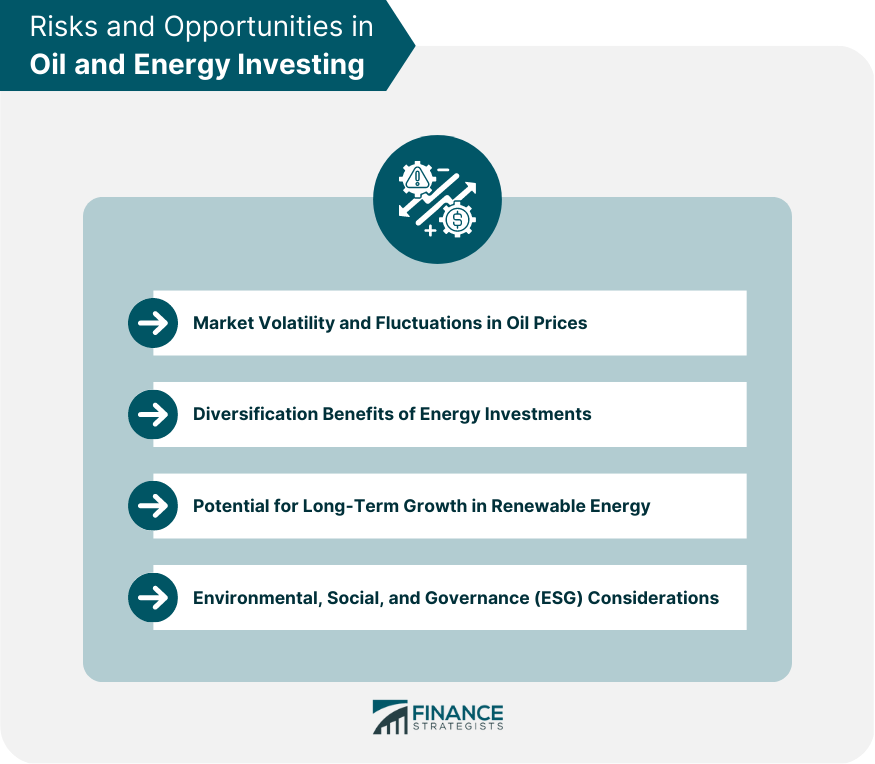Oil and energy investing refers to investing in companies that are involved in the production, exploration, refining, and distribution of oil, natural gas, and other forms of energy. This can include investing in traditional oil and gas companies and newer, alternative energy companies that produce wind, solar, and other forms of renewable energy. Investing in oil and energy companies can attract investors because energy is a fundamental component of modern economies, and demand for energy is likely to remain high in the long term. However, the energy sector can be volatile due to fluctuations in commodity prices and government policy and regulation changes. Investors can gain exposure to the oil and energy sector by investing in individual stocks or exchange-traded funds (ETFs) that track the energy industry's performance. The oil and energy sector is vital to the global economy, providing the energy necessary for transportation, industrial production, and domestic use. It encompasses a wide range of industries, including oil and gas extraction, energy infrastructure, and renewable energy sources such as solar, wind, and hydropower. As such, investors have numerous opportunities to participate in this dynamic and growing sector. Oil and energy investments can play a crucial role in a diversified investment portfolio, offering both growth potential and income opportunities. They can also provide a hedge against inflation, as energy prices often rise during periods of increasing inflation. Furthermore, investing in the energy sector can help spread risk across different industries and assets, enhancing overall portfolio performance. As with any investment, it is important to conduct thorough research and carefully consider the risks and potential returns before investing in oil and energy companies. These are large, multinational corporations with integrated operations, including exploration, production, refining, and marketing of oil and natural gas. Examples include ExxonMobil, Chevron, and Royal Dutch Shell. Major oil companies offer investors stability, global diversification, and attractive dividend yields. Independent oil and gas producers focus primarily on exploring and producing oil and natural gas without refining or marketing operations. Examples include EOG Resources and ConocƒdiveroPhillips. These companies may offer higher growth potential than major oil companies, but they are often more sensitive to fluctuations in oil prices. These companies provide essential services and equipment to oil and gas producers, such as drilling, well completion, and production optimization. Examples include Schlumberger, Halliburton, and Baker Hughes. Investing in these companies allows investors to benefit from increased oil and gas production without taking on the direct risks associated with exploration and production. MLPs are publicly traded partnerships that typically own and operate energy infrastructure assets, such as pipelines and storage facilities. They offer investors attractive income opportunities through regular distributions and potential capital appreciation. Examples of MLPs include Enterprise Products Partners and Energy Transfer. These companies own and operate pipelines, storage facilities, and other infrastructure assets that transport and store oil, natural gas, and refined products. Investing in these companies can provide stable income, as their revenues are often based on long-term contracts with relatively low exposure to commodity price fluctuations. These companies are involved in developing, constructing, and operating renewable energy projects, such as solar farms, wind turbines, and hydropower plants. Examples include NextEra Energy, First Solar, and Brookfield Renewable Partners. Investing in these companies allows investors to participate in the growing demand for clean and sustainable energy sources. Biofuels and biomass producers convert organic materials, such as corn, soybeans, and wood, into renewable fuels and energy. Examples include Renewable Energy Group and Enviva Partners. These investments can provide exposure to the increasing use of biofuels as an alternative to traditional fossil fuels. These funds invest in a diversified portfolio of energy companies, including oil and gas producers, energy infrastructure, and renewable energy sources. Examples of broad energy sector funds include the Energy Select Sector SPDR Fund (XLE) and the Vanguard Energy ETF (VDE). These funds offer investors a convenient way to gain exposure to the entire energy sector with a single investment. Focused funds invest primarily in either oil and gas companies or renewable energy companies. Examples include the VanEck Vectors Oil Services ETF (OIH) and the Invesco Solar ETF (TAN). These funds allow investors to target specific segments of the energy sector based on their investment preferences and risk tolerance. The performance of oil and energy investments is closely linked to the price of crude oil, which is influenced by various supply and demand factors. These include global economic growth, changes in production levels by major oil-producing countries, and the availability of alternative energy sources. Geopolitical events, such as conflicts in oil-producing regions, trade disputes, and changes in government policies, can significantly impact oil prices and the performance of oil and energy investments. Technological advancements in oil and gas extraction, such as hydraulic fracturing and horizontal drilling, have increased production and lower costs for oil and gas companies. These improvements can boost the performance of oil and energy investments. The ongoing development of more efficient and cost-effective renewable energy technologies, such as solar panels and wind turbines, can drive growth in the renewable energy sector and enhance the performance of related investments. Government regulations, such as restrictions on drilling and production, can influence the performance of oil and energy investments by affecting the supply of oil and natural gas. Growing concerns about climate change and the transition towards cleaner energy sources can impact the performance of traditional oil and gas investments while providing opportunities for growth in the renewable energy sector. The oil and energy sector is known for its volatility, with oil prices often experiencing significant fluctuations due to changes in supply, demand, and geopolitical factors. This volatility can create both risks and opportunities for investors. Investing in the energy sector can provide diversification benefits for a portfolio, as energy investments often have low correlations with other asset classes, such as stocks and bonds. As the world continues to transition towards cleaner and more sustainable energy sources, the renewable energy sector offers significant long-term growth potential for investors. Investors who prioritize ESG factors may favor renewable energy investments over traditional oil and gas investments due to concerns about the environmental impact of fossil fuels and the potential risks associated with climate change. Investors should carefully evaluate the financial health and performance metrics of oil and energy companies, considering factors such as revenue growth, profitability, and balance sheet strength. Additionally, assessing the management team and competitive advantages can provide valuable insights into a company's potential for success. Technical analysis can help investors identify trends and potential entry points in the oil and energy sector by analyzing factors such as price patterns, moving averages, and trading volume. Investors should maintain and build a diversified portfolio of energy investments, including a mix of oil and gas stocks, energy infrastructure investments, and renewable energy companies. This diversification can help mitigate risks associated with fluctuations in oil prices and changing market conditions. Investors should consider their investment time horizon and risk tolerance when developing an oil and energy investment strategy. Long-term investors may focus on identifying high-quality companies with strong growth potential, while short-term investors may seek to capitalize on market volatility and price fluctuations. The ongoing transition to renewable energy sources is reshaping the landscape of oil and energy investing. While oil remains an important component of the global economy, the growth of renewable energy sources presents new investment opportunities for investors seeking to participate in the shift towards a more sustainable energy future. As the oil and energy sector evolves, investors must stay informed about market trends, technological advancements, and regulatory changes to make well-informed investment decisions. By employing sound investment strategies and maintaining a diversified portfolio, investors can navigate the complex world of oil and energy investing and capitalize on its opportunities. If you are considering investing in the oil and energy sector, seeking professional guidance from a wealth management firm may be beneficial. A wealth manager can help you develop a tailored investment strategy that aligns with your financial goals, risk tolerance, and investment preferences.What Is Oil and Energy Investing?
Types of Oil and Energy Investments
Oil and Gas Stocks
Major Oil Companies
Independent Oil and Gas Producers
Oilfield Services and Equipment Providers
Energy Infrastructure Investments
Master Limited Partnerships (MLPs)
Pipeline and Storage Companies
Renewable Energy Investments
Solar, Wind, and Hydropower Companies
Biofuels and Biomass Producers
Energy Exchange-Traded Funds (ETFs) and Mutual Funds
Broad Energy Sector Funds
Focused Oil or Renewable Energy Funds

Factors Influencing Oil and Energy Investment Performance
Crude Oil Prices and Market Dynamics
Supply and Demand Factors
Geopolitical Influences
Technological Advancements in the Energy Sector
Improved Extraction Techniques
Advancements in Renewable Energy Technologies
Regulatory and Environmental Policies
Impact of Government Regulations on Oil Production
Climate Change and the Push for Renewable Energy

Risks and Opportunities in Oil and Energy Investing
Market Volatility and Fluctuations in Oil Prices
Diversification Benefits of Energy Investments
Potential for Long-Term Growth in Renewable Energy
Environmental, Social, and Governance (ESG) Considerations

Strategies for Successful Oil and Energy Investing
Fundamental Analysis of Oil and Energy Companies
Technical Analysis for Market Timing and Entry Points
The Bottom Line
Oil and Energy Investing FAQs
The main types of oil and energy investments include oil and gas stocks (major oil companies, independent producers, and oilfield services providers), energy infrastructure investments (Master Limited Partnerships and pipeline/storage companies), renewable energy investments (solar, wind, and hydropower companies, as well as biofuels and biomass producers), and energy exchange-traded funds (ETFs) and mutual funds (broad energy sector funds and focused oil or renewable energy funds).
The performance of oil and energy investments is closely linked to the price of crude oil, which is influenced by various supply and demand factors, such as global economic growth, changes in production levels, and the availability of alternative energy sources. Oil price fluctuations can create risks and opportunities for investors in the oil and energy sector.
Risks associated with oil and energy investing include market volatility and fluctuations in oil prices, the impact of government regulations on oil production, and the transition towards cleaner energy sources, which can negatively affect traditional oil and gas investments while providing opportunities for growth in the renewable energy sector.
Investors can manage the risks associated with oil and energy investing by employing sound investment strategies, such as fundamental and technical analysis, maintaining a diversified portfolio of energy investments, and considering their investment time horizon and risk tolerance when developing an investment strategy.
The future of oil and energy investing will be shaped by the ongoing transition to renewable energy sources, technological advancements in the energy sector, and changes in regulatory and environmental policies. While oil remains an important component of the global economy, the growth of renewable energy sources presents new investment opportunities for investors seeking to participate in the shift towards a more sustainable energy future.
True Tamplin is a published author, public speaker, CEO of UpDigital, and founder of Finance Strategists.
True is a Certified Educator in Personal Finance (CEPF®), author of The Handy Financial Ratios Guide, a member of the Society for Advancing Business Editing and Writing, contributes to his financial education site, Finance Strategists, and has spoken to various financial communities such as the CFA Institute, as well as university students like his Alma mater, Biola University, where he received a bachelor of science in business and data analytics.
To learn more about True, visit his personal website or view his author profiles on Amazon, Nasdaq and Forbes.











